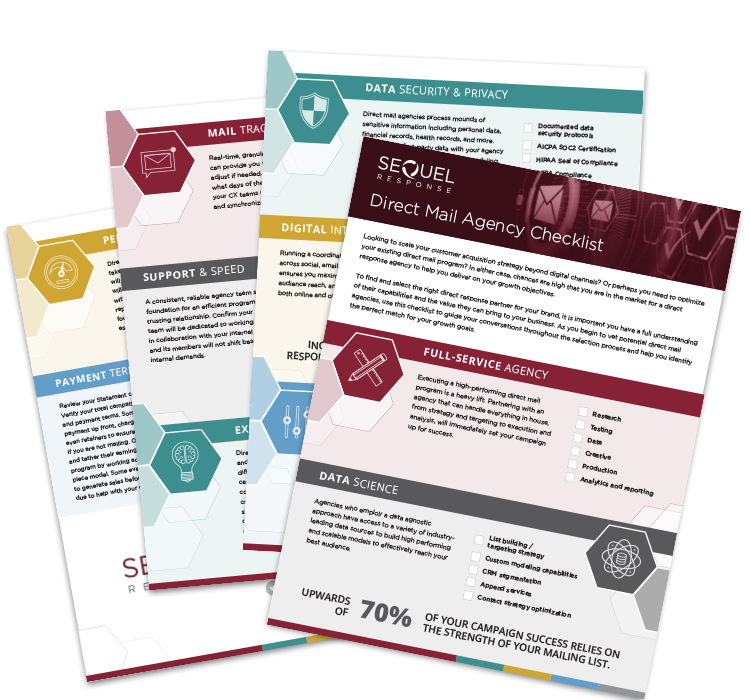ChatGPT and Direct Response Copywriting
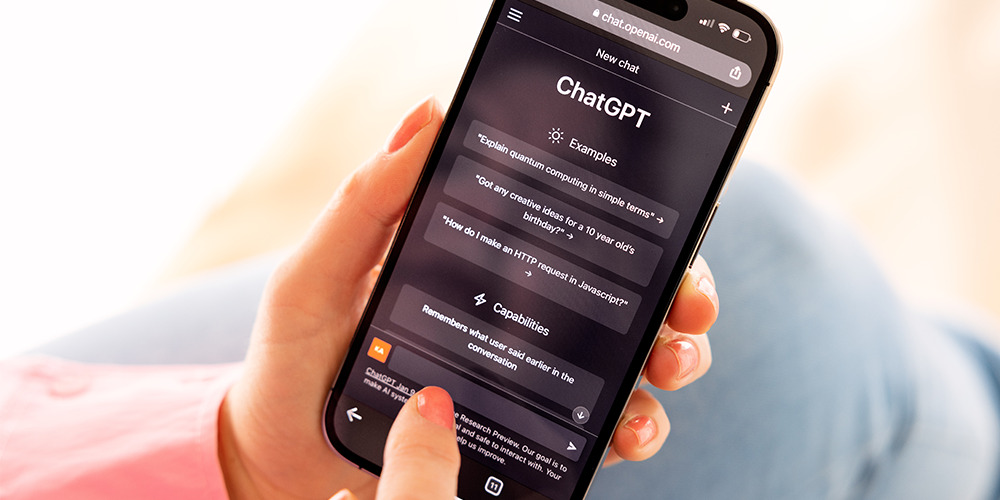
Artificial intelligence (AI) used to be a mere concept in our minds, expected to emerge in the distant future. However, all of that changed when AI tools were gradually introduced to the world over the past couple of years. Although these platforms had already proven to be dependable assistants capable of performing various functions, none of them had truly captured the world’s attention … until now.
It’s safe to say that nobody anticipated the velocity at which ChatGPT would dominate our minds, discussions, and social media feeds. It has had internet users buzzing since its release in November 2022, becoming the fastest-growing online consumer application. Within two short months, the tool reached one hundred million users.
ChatGPT can generate coherent and convincingly human-like text within seconds. Plus, it is currently free of charge, luring in marketing teams in search of quick fixes. While there are a variety of ways you can use ChatGPT to optimize your workday and scale your advertising efforts, there is one function that stands out to us: direct response copywriting.
Beyond Algorithms: The Value of Human-Developed Creative for Direct Response Success
Direct response marketing campaigns are time-consuming and expensive, so there is no doubt why this free online tool has sparked curiosity. Some marketing teams may use ChatGPT as a quick alternative to sitting down and writing ad copy for display ads, social media content, direct mail pieces, and other marketing materials.
However, it takes a human to truly balance the information gained from client conversations with proven direct mail tactics and evolving creative trends. That subtle, but key trifecta results in a piece that will likely strike a stronger connection with the prospect, giving it the best chance of response.
To prove the value of human creative development, we decided to test ChatGPT and direct response copywriting with an 8.5 x 5.5 direct mail postcard.
Keep reading for a fascinating comparison between an AI-generated mailer and one made by humans. We have invited our Creative Director, Tari Johnson, to share her professional insights on the crucial impact of decisions made by the direct mail designer and copywriter, as well as the value of their collaboration with the client throughout creative development.
Below is our process from start to finish, breaking down each step along the way:
Sip & Script: Testing ChatGPT and Direct Response Copywriting Skills
To kick off our ChatGPT test, we chose a brand renowned for their alluring creative. This online wine distributor competes against big box stores while aiming for high-end luxury. Stunning visuals and chic language are essential for sparking feelings of luxury, urging consumers to indulge themselves with an elegant treat, and denoting their brand identity.
At SeQuel Response, every direct mail campaign we touch includes a client brief with specific requirements and expectations for the mail piece. For this experiment, we started by sharing the client brief information with ChatGPT. We then asked it to write copy for the direct mail postcard. We anticipated our first engagement to be haphazard since this AI tool requires highly-specific prompts and language to provide you with what you need.
PROMPT 1: Develop copy for an 8.5 x 5.5 direct mail postcard. Brand is a high-end online wine distributor who competes with big-box stores. The offer is $100 off your $300 order. Include mention of over 10,000 bottle options and fast shipping.
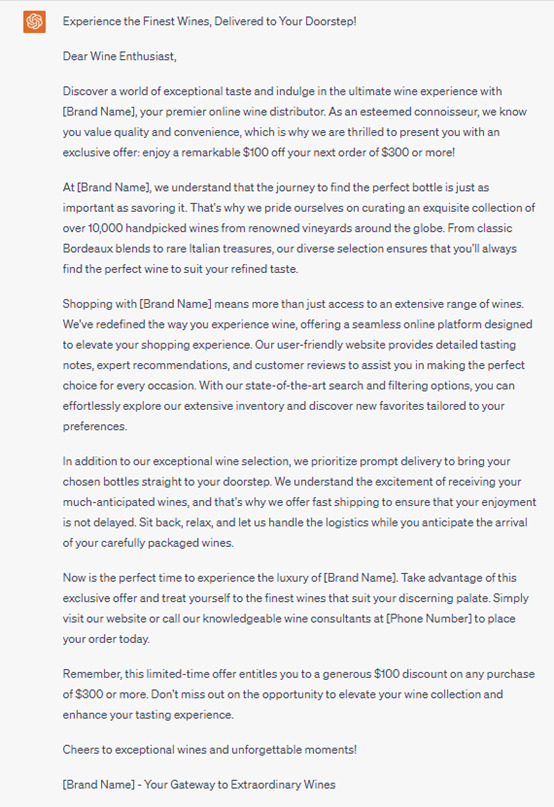
If you look above, you’ll see lengthy, letter-like text. Attention spans continue to shrink, so it’s important to be precise with your direct mail copy. In fact, word count in mailers has declined by 62%. This is not what the client is looking for, so we tell ChatGPT to narrow down its copy for postcard specs.
PROMPT 2: Simplify to less than 100 words.

Although ChatGPT did what it was told, it is hard to determine the text placement. We also cannot differentiate headers from the additional copy. We need to ask the tool to specify this information.
PROMPT 3: Identify the front side of postcard and backside of postcard copy. Include two engaging headlines.
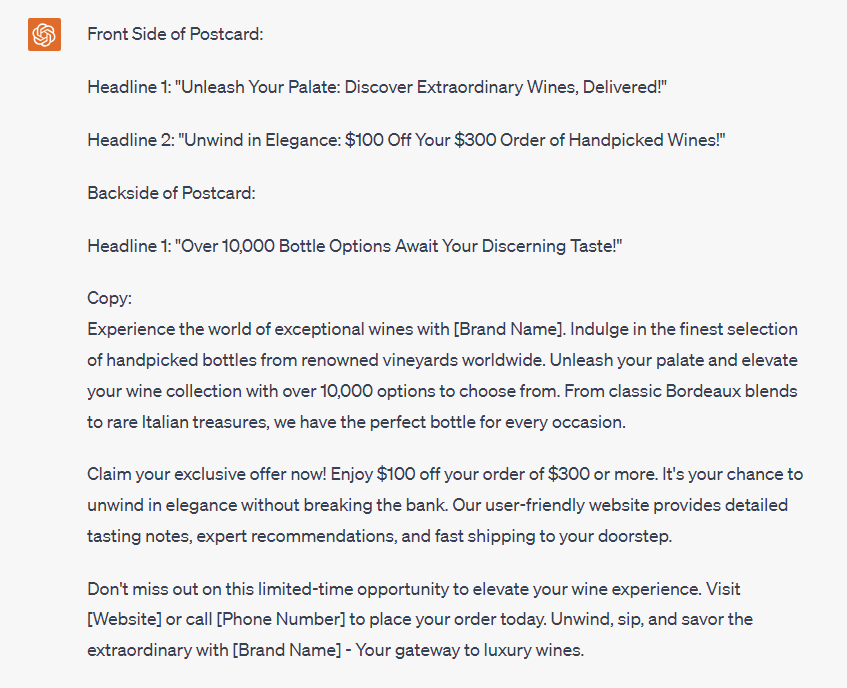
We are starting to get somewhere, but this is still quite wordy. One of the best ways to maximize your direct mail postcard impact is to leverage bullet points and/or icons to emphasize important content while making your piece easily scannable. You’ll see the difference in the example created by the SeQuel Response creative team later in this article.
We ask ChatGPT to shorten their copy further.
PROMPT 4: Reduce copy to three short statements.
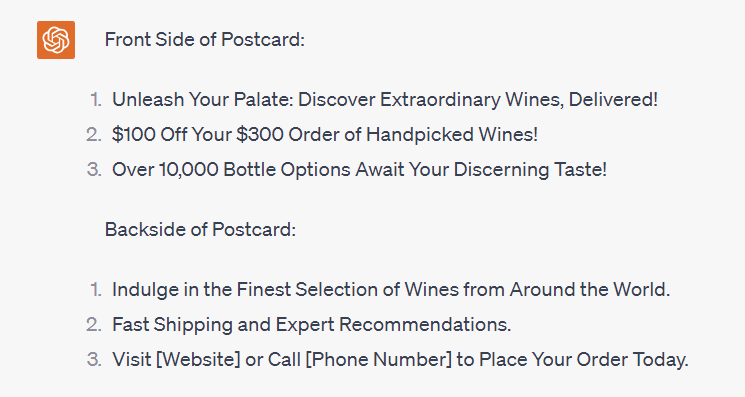
Now we know which side of the postcard each piece of text should go, and it’s shorter, which is what we were looking for. To get even more specific, we ask ChatGPT to recommend imagery and copy placement.
PROMPT 5: Recommend imagery and copy placement for the postcard.
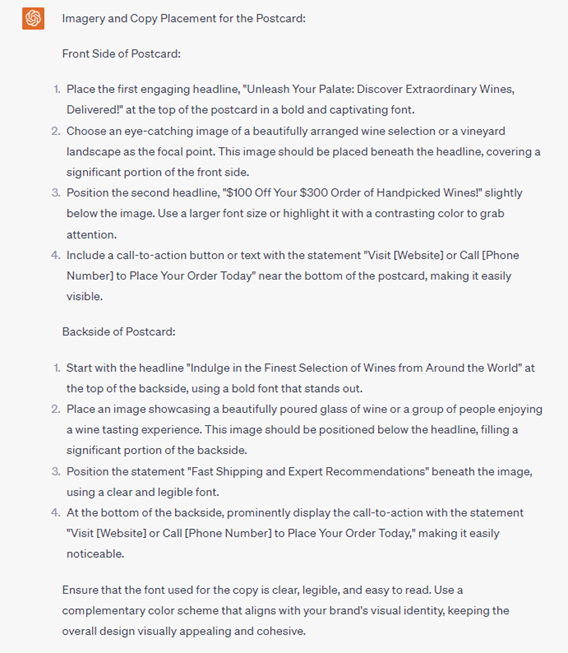
This is where we struck gold, feeling confident enough to end the conversation and move forward with the experiment.
A Taste of AI Creativity: Presenting ChatGPT’s Postcard Design
After five prompts, ChatGPT provided enough detail to aid in crafting a direct mail postcard. It recommended headers, copy, and where to place content and imagery. With these instructions, we designed a postcard.
Here is the result:
 |
 |
Above you will see a simple design that hits every item on the client brief and aligns with the ChatGPT recommendations. The entire ChatGPT prompt and design process took no more than half an hour.
We can confidently say that ChatGPT is fully capable of “designing” a direct mail postcard from start to finish – including what copy to include, where to place the copy, and how to place all other visuals on the postcard. On top of that, its work here was completely free. It was a quick and effortless way to perform the normal duties of a creative designer and mimic a process that would otherwise require a significant amount of time and money.
But is that enough? Does the execution match the level of what an experienced copywriter and designer would create? It’s important to reflect on what went right here, as well as what could have been better.
A Full-Bodied Experience: Direct Mail Developed by Pros
Dedication and determination lead to excellent results. Below you will find the brand’s actual postcard, which our creative team intentionally designed with direct response best practices, purpose, and experience leading every decision.
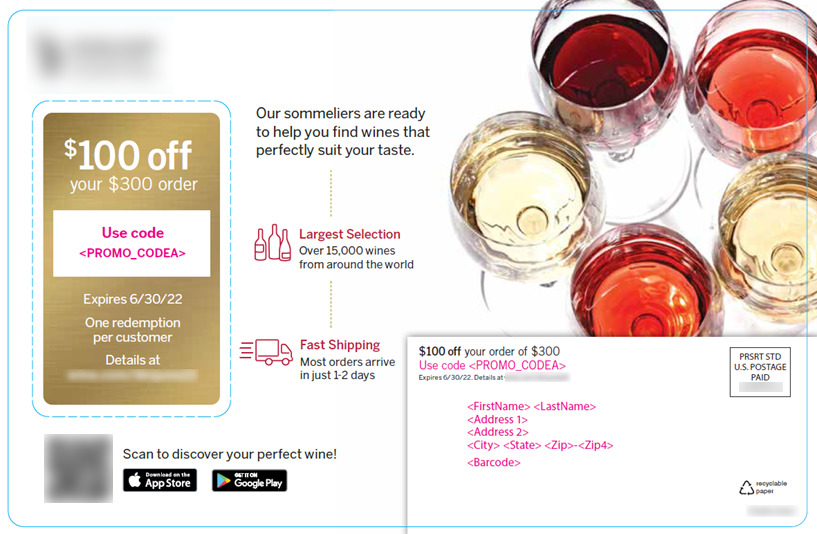 |
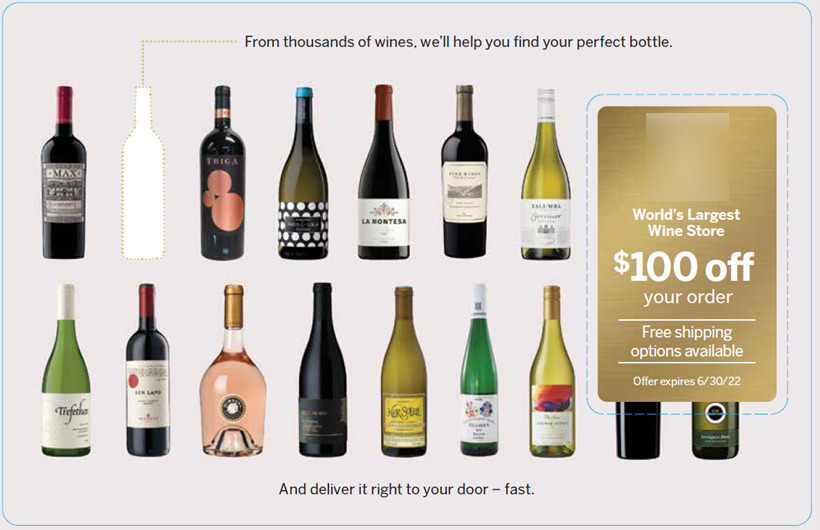 |
“The nuances in human collaboration are key to developing a truly winning piece of direct mail,” explained Tari Johnson, Creative Director at SeQuel Response. “It starts with drawing on the history of results specific to direct mail tactics as they relate to the client’s industry, as well as larger trends. From there, it’s important to pay mind to the history of what has worked for that client. Their audience may respond better to something such as featuring their app, whereas another company in the same industry may not have a strong app worth promoting. In this case, highlighting it could have the opposite effect. It’s incredibly important to listen to the client and pick up on their tone of voice and non-verbal cues to better understand what resonates with them as they may not be able to articulate it in a way that translates to creative output.”
Toast to Efficiency: The Advantages of Using ChatGPT for Direct Mail Copy
Many brands leverage AI tools to make decisions quickly and efficiently for their campaigns. It has many benefits, and this test proves its ability to assist with all sorts of tasks. Here are the benefits of ChatGPT and direct response copywriting:
- It gets the job done. This postcard is clear, clean, and concise. The imagery matches the brand well, and it includes the right information.
- The tool’s abilities extend to many areas. Notably, ChatGPT’s usefulness extends to targeting, demographics, lookalike modeling, and fine-tuning your tone of voice to best meet the preferences of your audience.
- It is quick and user-friendly. With this dependable brainstorming partner, our workday was quickly and efficiently optimized, eliminating wasted time on prolonged tasks.
- It is useful for simple projects. If you are an aspiring entrepreneur or a startup business who wants to see what a postcard could potentially look like without spending too much time or money on resources to meet that demand, give ChatGPT a try and see if it can help you produce any clever ideas. Whenever you need a little nudge to get you in the right direction, this popular AI mastermind could be a great resource for you.
- It is great for inspiration. Think of ChatGPT as a content creation companion that can help you quickly gather information and inspiration. If you are ever feeling stuck on a header or where to place the CTA, it will assist you in getting to where you need to be. It’s a great tool for anyone overcoming writer’s block or creative stagnation.
The Bitter Notes: The Challenges of Using ChatGPT for Direct Mail Copy
While a useful tool, ChatGPT has several limitations worth acknowledging. It may lend a helping hand, but the copy it outputs still needs to be touched by professionals. Here are a few limitations:
- Lack of knowledge from past campaigns. Experienced agencies share valuable insights gained through historical data, identifying key drivers for response based on past campaigns. This knowledge is instrumental in crafting successful strategies. For instance, ChatGPT may not fully grasp the nuances of positioning a brand, such as presenting it as a high-end offering for a particular client.
- No variability. ChatGPT cannot provide variable data required to personalize mailers, missing the opportunity to create a custom postcard for each consumer on the mailing list.
- It is not a visual mastermind. The imagery used in AI-version of the postcard lacks engagement, and ChatGPT did not recommend incorporating a QR code, which could have been beneficial. QR codes are well-liked in postcards as they encourage interactivity, driving the audience to a personalized URL (PURL) where they can sign up, order products, or chat with a representative.
- The fine print. A crucial concern is the potential for copywrite infringement when using AI tools like ChatGPT. The terms and conditions of such tools often grant them the right to use suggested content however they please, which could lead to your mail pieces inadvertently resembling those of your competitors.
- Security risks and hackers. It is advised not to input confidential information into AI bots, as there’s no guarantee where that data might end up. Sometimes, opting for the more secure and time-consuming approach can outweigh the convenience of using AI tools.
- It is not a human. The human creative process involves subtle cues during conversations, consideration of context, client history, a creative mindset, and the incorporation of new features. Whereas ChatGPT lacks the ability to capture everything that a real conversation does. Its output lacks a sense of creativity, depth, and perspective, generating text that tends to be more generic.
If there’s anything we’ve learned from this experiment, it’s that nothing beats human intuition. If you ever find yourself feeling unconfident, use your human emotions to your advantage, because that is one thing that we have that ChatGPT doesn’t.
On top of that, campaign history and trends serve as invaluable resources and should be prioritized above all else. It is essential to conduct thorough testing to identify what strategies are effective and what are not. Collaboration with your human team members is also crucial, emphasizing the importance of maintaining open and effective communication throughout the process.
Copywriting does take time, but so do other processes that end up with great results. ChatGPT is a great helping hand when you need some inspiration, but don’t fear that it will replace a creative’s job. And remember, the performance of your direct mail program relies on so much more than your postcard design.
If you want to learn more about the benefits of connection and collaboration, contact a SeQuel strategist today, download our free direct mail creative e-book, or check out this piece for direct mail examples.
